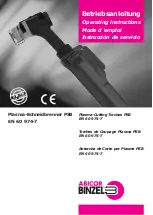
B-11
OPERATION
VANTAGE
®
520 SD
COMMON WELDING PROCEDURES
MAKING A WELD
The serviceability of a product or structure utilizing the welding
programs is and must be the sole responsibility of the builder/user.
Many variables beyond the control of The Lincoln Electric Company
affect the results obtained in applying these programs. These
variables include, but are not limited to, welding procedure, plate
chemistry and temperature, weldment design, fabrication methods
and service requirements. The available range of a welding
program may not be suitable for all applications, and the build/user
is and must be solely responsible for welding program selection.
Choose the electrode material, electrode size, shielding gas, and process
(GMAW, GMAW-P etc.) appropriate for the material to be welded.
Select the weld mode that best matches the desired welding process.
The standard weld set shipped with the VANTAGE
®
520 SD
encompasses a wide range of common processes that will meet
most needs. If a special weld mode is desired, contact the local
Lincoln Electric sales representative.
All adjustments are made through the user interface. Because of the
different configuration options your system may not have all of the
following adjustments.
See Accessories Section for Kits and Options available to use with the
VANTAGE
®
520 SD.
DEFINITION OF WELDING MODES
NON-SYNERGIC WELDING MODES
• A
Non-synergic welding
mode requires all welding process
variables to be set by the operator.
SYNERGIC WELDING MODES
• A
Synergic welding
mode offers the simplicity of single knob
control. The machine will select the correct voltage and amperage
based on the Wire Feed Speed (WFS) set by the operator.
BASIC WELDING CONTROLS
Weld Mode
Selecting a weld mode determines the output characteristics of the
VANTAGE
®
520 SD power source. Weld modes are developed with
a specific electrode material, electrode size, and shielding gas. For a
more complete description of the weld modes programmed into the
VANTAGE
®
520 SD at the factory, refer to the Weld Set Reference
Guide supplied with the machine.
Wire Feed Speed (WFS)
In synergic welding modes (synergic CV, GMAW-P), WFS is the
dominant control parameter. The user adjusts WFS according to factors
such as wire size, penetration requirements, heat input, etc. The
VANTAGE
®
520 SD then uses the WFS setting to adjust the voltage and
current according to settings contained in the VANTAGE
®
520 SD.
In non-synergic modes, the WFS control behaves like a conventional
power source where WFS and voltage are independent adjustments.
Therefore, to maintain proper arc characteristics, the operator must
adjust the voltage to compensate for any changes made to the WFS.
Amps
In constant current modes, this control adjusts the welding amperage.
Volts
In constant voltage modes, this control adjusts the welding voltage.
Trim
In pulse synergic welding modes, the Trim setting adjusts the arc
length. Trim is adjustable from 0.50 to 1.50. 1.00 is the nominal
setting and is a good starting point for most conditions.
UltimArc™ Control
UltimArc™ Control allows the operator to vary the arc charac-
teristics. UltimArc™ Control is adjustable from –10.0 to +10.0 with
a nominal setting of 0.0.
PULSE WELDING
Pulse welding procedures are set by controlling an overall “arc length”
variable. When pulse welding, the arc voltage is highly dependent upon
the waveform. The peak current, back ground current, rise time, fall
time and pulse frequency all affect the voltage. The exact voltage for a
given wire feed speed can only be predicted when all the pulsing
waveform parameters are known. Voltage or Trim can be adjusted.
Trim adjusts the arc length and ranges from 0.50 to 1.50 with a
nominal value of 1.00. Trim values greater than 1.00 increase the
arc length, while values less than 1.00 decrease the arc length.
(See figure B.15)
WARNING
Trim .50
Arc Length Short
Trim 1.00
Arc Length Medium
Trim 1.50
Arc Length Long
FIGURE B.15
Summary of Contents for VANTAGE 520 SD
Page 8: ...8 NOTES VANTAGE 520 SD ...
Page 20: ...A 12 NOTES VANTAGE 520 SD ...
Page 49: ...F 3 CONNECTION DIAGRAMS VANTAGE 520 SD ...
Page 50: ...F 4 CONNECTION DIAGRAMS VANTAGE 520 SD ...
Page 51: ...F 5 CONNECTION DIAGRAMS VANTAGE 520 SD ...
Page 56: ...F 10 NOTES VANTAGE 520 SD ...
















































